|
My United States Paper Money Collection |
|
One Dollar | Two Dollar | Five Dollar | Ten Dollar | Twenty Dollar | Fifty Dollar | Hundred Dollar | Miscellaneous
|
Two Dollar Bills |
|
Series 1896 Two Dollar Silver Certificate ("Educational")
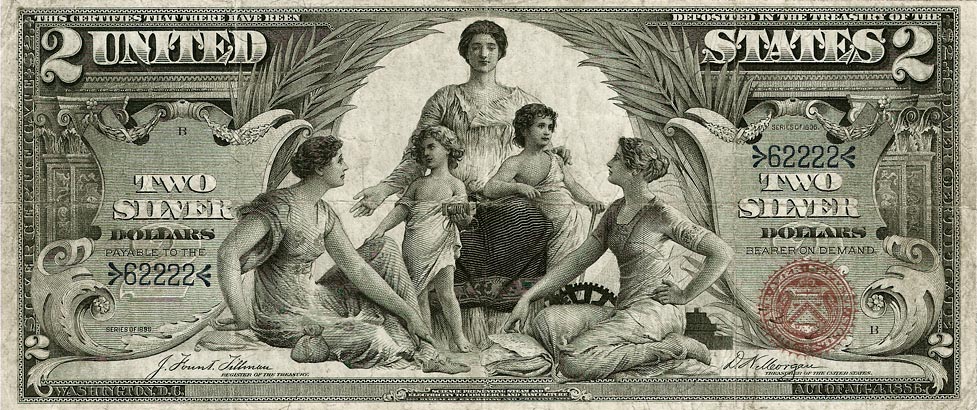
 
The Series 1896 Two Dollar Silver Certificate is the second note of the famous Educational Series of 1896 -- considered the most artistically designed of all U.S. currency issues -- and reflects a time in American history when currency was not just money but also a work of art. The obverse of this large-size (7 3/8 by 3 1/8 inches) note is an engraving entitled "Science presents Steam and Electricity to Commerce and Manufacture." The obligation clause on the obverse reads, "THIS CERTIFIES THAT THERE HAS BEEN DEPOSITED IN THE TREASURY OF THE UNITED STATES TWO SILVER DOLLARS PAYABLE TO THE BEARER ON DEMAND."
The reverse features portraits of both Robert Fulton and Samuel Morris and has a redemption clause that reads, "THIS CERTIFICATE IS REDEEMABLE FOR CUSTOMS, TAXES AND ALL PUBLIC DUES, AND WHEN SO RECEIVED MAY BE REISSUED."
|
|
Series 1899 Two Dollar Silver Certificate ("Mini Porthole")

  
The Series 1899 $1 Silver Certificate measures 7 3/8 by 3 1/8 inches and bears the distinctive blue seal and serial numbers that mark it as a genuine Silver Certificate. The obverse features a portait of George Washington inside a small ornate frame (which is why this note is sometimes referred to as the "Mini-Porthole" note) flanked by classically rendered figures of Mechanics and Agriculture. The obligation clause on the obverse reads, "THIS CERTIFIES THAT THERE HAS BEEN DEPOSITED IN THE TREASURY OF THE UNITED STATES TWO SILVER DOLLARS PAYABLE TO THE BEARER ON DEMAND."
The reverse features a redemption clause that states, "THIS CERTIFICATE IS REDEEMABLE FOR CUSTOMS, TAXES AND ALL PUBLIC DUES, AND WHEN SO RECEIVED MAY BE REISSUED."
|
|
Series 1917 Two Dollar Legal Tender Note
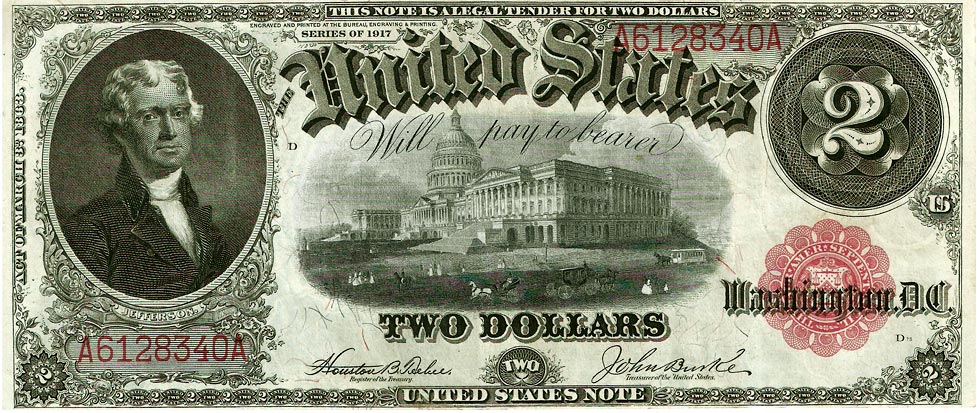
   
Legal Tender Notes (a.k.a United States Notes) circulated in America along with other types of currency in the early 20th century. The first Legal Tender Notes were issued during the Civil War as a way for the U.S. government to pay its debts. Since there was not enough silver and gold coinage to go around, the government issued paper currency instead. Paper currency was also safer and less bulky to transport. This type of paper money was printed with the words “legal tender” to assure the recipients that it was legitimate and that the U.S. government would fulfill its obligation to pay. Legal Tender Notes feature a red seal and red serial numbers, as opposed to blue seals and serial numbers on Silver Certificates and green seals and serial numbers on Federal Reserve Notes. The 1917 Two dollar bill is the last year for this design that was started in 1869.
Issued in the large size of 7-3/8 by 3-1/8 inches (about 50 percent larger than today’s paper currency), the design of the Series 1917 $2 Legal Tender Note reflects a time in American history when currency was not just money but also a work of art. The central image on the front is a rendering of the U.S. Capitol building, and to the left is a portrait of Thomas Jefferson. The obverse also bears the phrases, "THIS NOTE IS A LEGAL TENDER FOR TWO DOLLARS", "UNITED STATES NOTE" and "THE UNITED STATES Will pay to bearer TWO DOLLARS."
The reverse of the note features an abstract design that generally referred to as a "bracelet" (but which I have always thought looks more like a giant eyeball) and bears the text, "United States of America," as well as a redemption clause that states, "This Note is a LEGAL TENDER at its face value for all Debts Public and Private, except Duties on Imports and INTEREST ON THE PUBLIC DEBT." Also displayed on the back is a rather ominous warning about counterfeiting that reads, "Counterfeiting or Altering this Note or passing any Counterfeit or Alteration of it, or having in possession any false or counterfeit plate or impression of it, or any paper made in imitation of the Paper on which it is printed is a Felony, and is punishable by $5,000 fine, or 15 years imprisonment at Hard Labor or both." One final oddity of this note is the phrase "PRINTED AT THE BUREAU OF ENGRAVING AND PRINTING" found on the left hand side of the reverse.
|
Series 1918 Two Dollar Federal Reserve Bank Note
(Boston, Massachusetts)

 
1918 is the last year that large size two dollar bills were issued by the United States. Known also as National Currency, the Series 1918 Federal Reserve Bank Note measures 7 3/8 by 3 1/8 inches and displays a portrait of Thomas Jefferson on the face, while the back features an engraved vignette of a Battleship (which is why this note is usually referred to as "the Battleship note"). The note has the blue seal and serial numbers that are more typically found on Silver Certificates, but the obligation clause states, "SECURED BY UNITED STATES CERTIFICATES OF INDEBTEDNESS OR UNITED STATES ONE-YEAR GOLD NOTES, DEPOSITED WITH THE TREASURER OF THE UNITED STATES OF AMERICA" and the note indicates that the issuing bank will "PAY TO THE BEARER ON DEMAND TWO DOLLARS." The obverse also states, "AUTHORIZED BY THE ACTS OF DEC. 23, 1913 AND APRIL 23, 1918." Despite the fact that this is a Series 1918 note, which is clearly marked, the obverse of the note also bears the date May 18, 1914. Issued by the Federal Reserve Bank of Boston, Massachusetts, this note features signatures from both U.S. government officials and bank officials.
The reverse of the note displays a redemption clause that reads, "THIS NOTE IS RECEIVABLE AT PAR IN ALL PARTS OF THE UNITED STATES IN PAYMENT OF ALL TAXES AND EXCISES AND ALL OTHER DUES TO THE UNITED STATES EXCEPT DUTIES ON IMPORTS AND ALSO FOR ALL SALARIES AND OTHER DEBTS AND DEMANDS OWING BY THE UNITED STATES TO INDIVIDUALS CORPORATIONS AND ASSOCIATIONS WITHIN THE UNITED STATES EXCEPT INTEREST ON PUBLIC DEBT."
Note that, since these notes were issued by individual banks, the scarcity and value of these notes depends greatly on the issuing bank as well as their condition.
|
|
Series 1928F "Red Seal" Two Dollar Legal Tender Note

 
Legal Tender Notes, also known as United States Notes, were introduced during the Civil War. The size was reduced to modern standards beginning with Series 1928. The face of the small-size $2 Legal Tender Note features a central portrait of Thomas Jefferson, while the back depicts his home, Monticello. It also bears the distinctive red seal and serial numbers unique to Legal Tender Notes. The obligation clause on the obverse reads, "THIS NOTE IS A LEGAL TENDER AT ITS FACE VALUE FOR ALL DEBTS, PUBLIC AND PRIVATE." Also included on the obverse are the phrases, "UNITED STATES NOTE" and "THE UNITED STATES OF AMERICA WILL PAY TO THE BEARER ON DEMAND TWO DOLLARS."
|
|
Series 1953C "Red Seal" Two Dollar Legal Tender Note
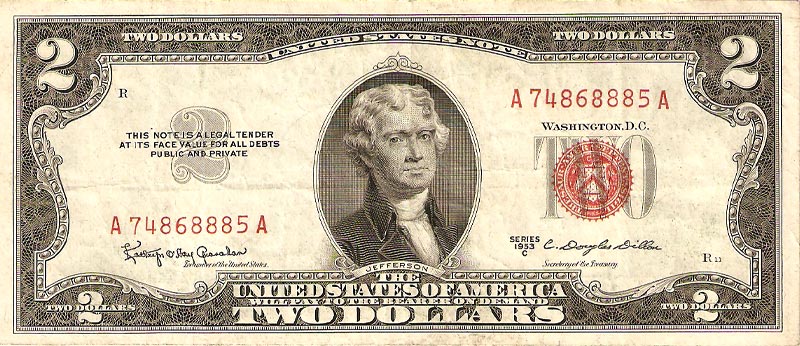
 
The design of the $2 Legal Tender Note was redesigned slightly in 1953. It still featured a central portrait of Thomas Jefferson on the obverse with Monticello on the reverse, but the size and location of various elements on the obverse were changed.
|
|
Series 1963 "Red Seal" Two Dollar Legal Tender Note
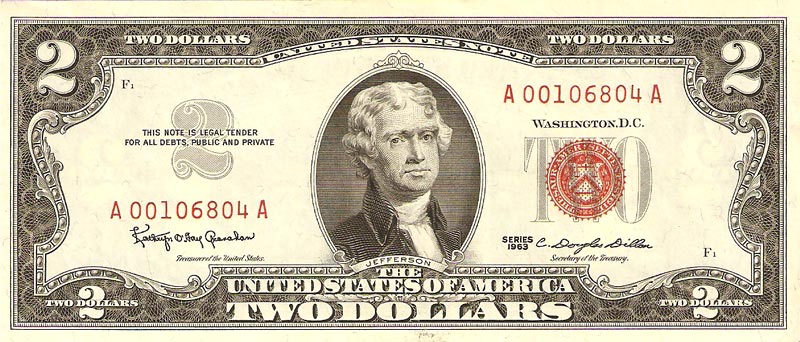
 
The design of the $2 Legal Tender Note was left mostly intact for the re-issue of 1963. The main differences on the obverse are that the obligation clause now states "THIS NOTE IS LEGAL TENDER FOR ALL DEBTS, PUBLIC AND PRIVATE" instead of "THIS NOTE IS A LEGAL TENDER AT ITS FACE VALUE FOR ALL DEBTS, PUBLIC AND PRIVATE" and the phrase "WILL PAY TO THE BEARER ON DEMAND" no longer appears below Jefferson's portrait to indicate the fact that U.S. currency was now considered fiat money, unbacked by any physical asset. On the reverse, the words "IN GOD WE TRUST" were added above the image of Monticello.
|
|
Series 1976 Two Dollar Federal Reserve Note
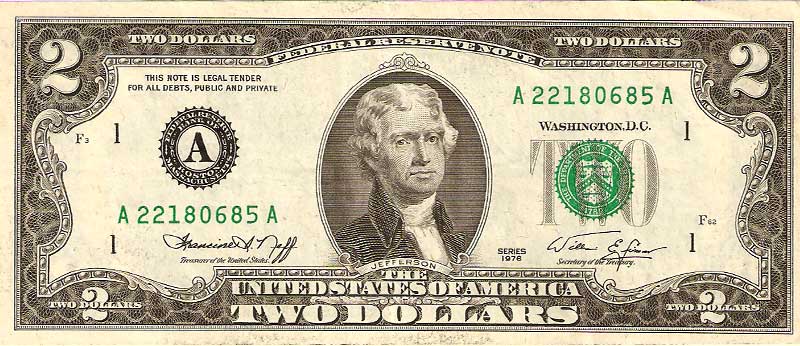
 
On April 13, 1976, the very first $2 Federal Reserve Note were issued. The obverse continued to bear a portrait of Thomas Jefferson. To celebrate the bicentennial of American independence, however, the reverse was completely redesigned to feature the famous painting, "The Signing of the Declaration of Independence." As with all modern-day Federal Reserve Notes, the obverse also bears a green Treasury Seal on the right and a black seal on the left bearing the identity of the Federal Reserve Bank of issuance. The regional seal is a design facet unique to Federal Reserve Notes, because almost all other types of notes were issued directly by the U.S. Treasury. The obligation clause on the obverse reads simply, "THIS NOTE IS LEGAL TENDER FOR ALL DEBTS, PUBLIC AND PRIVATE." Also included on the obverse are the phrases, "FEDERAL RESERVE NOTE" and "THE UNITED STATES OF AMERICA TWO DOLLARS."
[NOTE: Although rarely seen in circulation today, $2 Federal Reserve Notes are still being produced by the Bureau of Engraving and Printing and later series -- including the current Series 2009 -- have remained largely unchanged with the exception of the signatures of the Treasurer and Secretary of the Treasury.]
|
|
One Dollar | Two Dollar | Five Dollar | Ten Dollar | Twenty Dollar | Fifty Dollar | Hundred Dollar | Miscellaneous
|
|
|